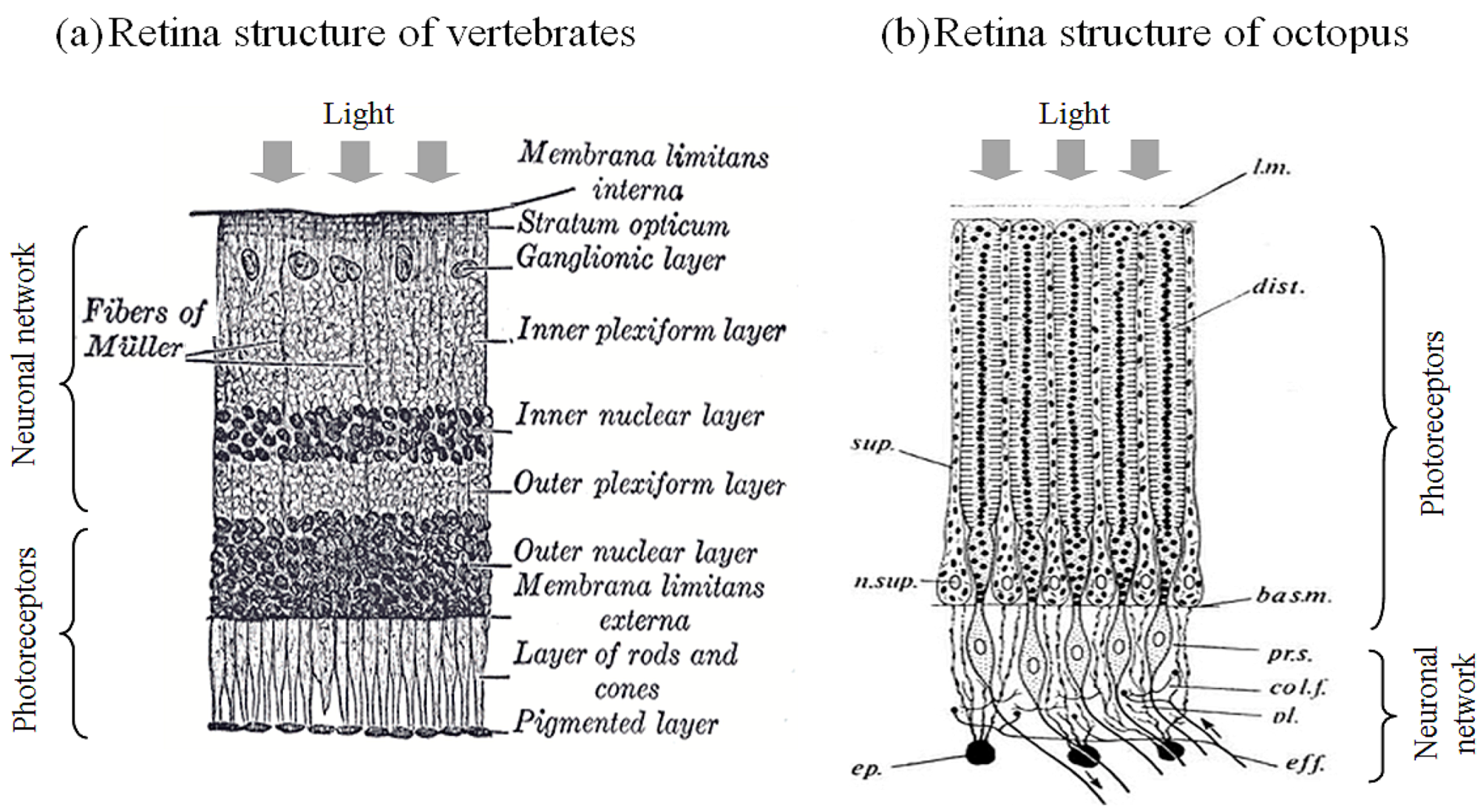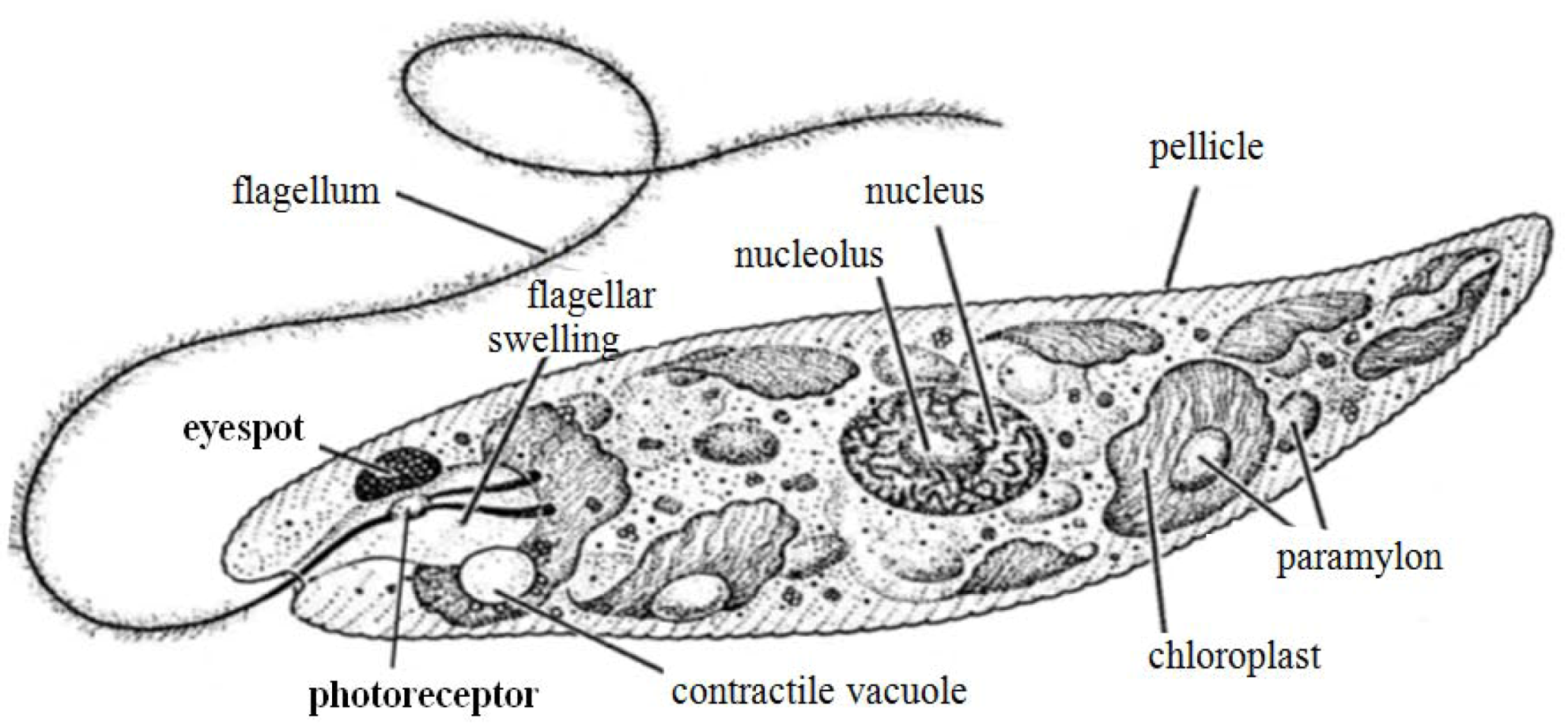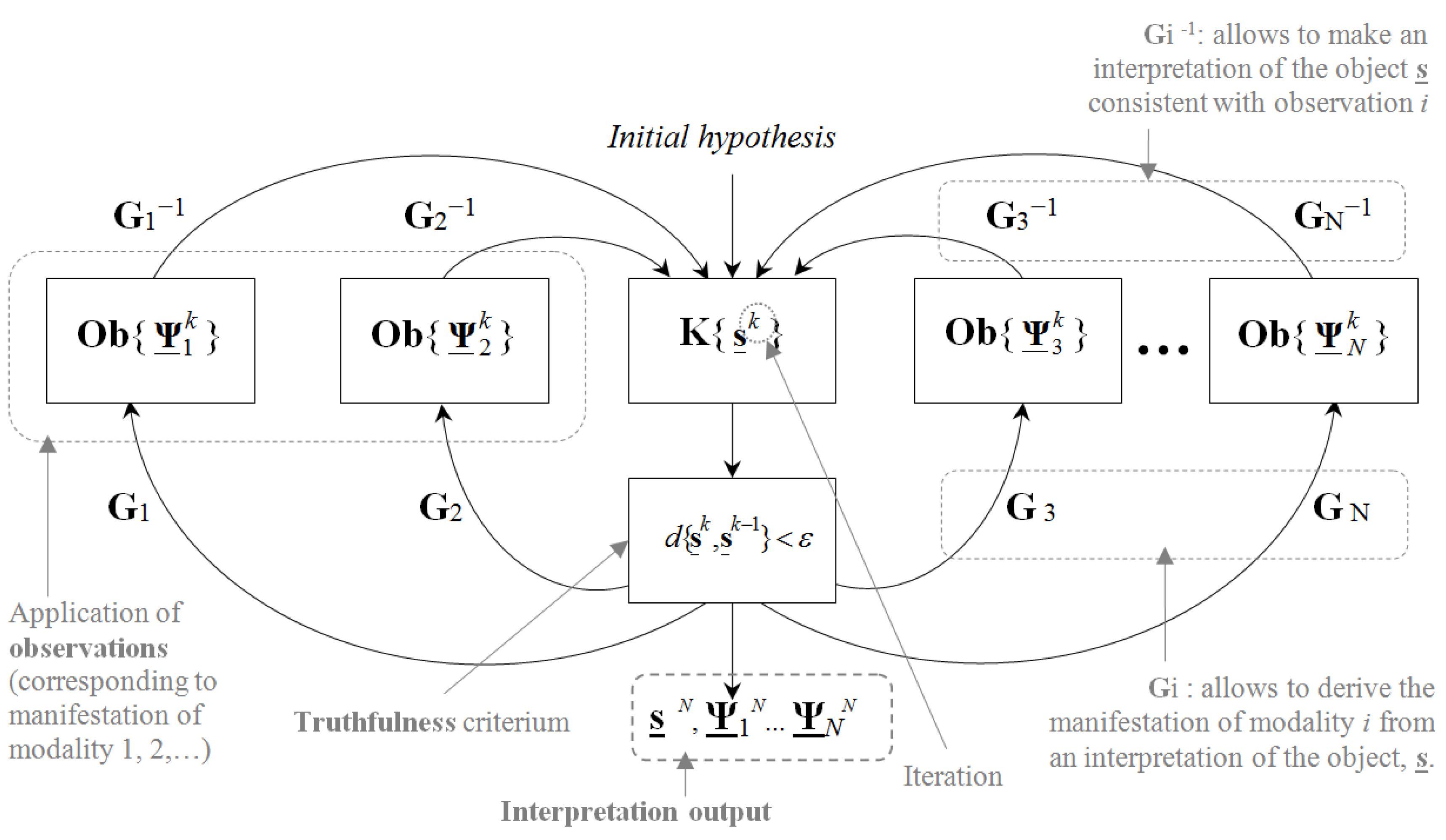Emergence and Evolution of Meaning: The General Definition of Information (GDI) Revisiting Program—Part 2: The Regressive Perspective: Bottom-up
Abstract
:1. Introduction
“… Our uncultivated eyesight […] cannot show us any other more notable parts. […] But we are practised in the discipline which discloses the causes of things, shakes off deceptions of eyesight, and carries the mind higher and further, outside of the boundaries of eyesight.”(Kepler, Epitome of Copernican Astronomy, IV, §I.1 [1])
2. Manifestation of Reality as Emergence
2.1. Physical Limits of the Manifestation of Reality
 , as illustrated in Figure 1a, can be directly handled by the usage of the Maxwell equations. The straightforward linearity of these equations allows us to apply superposition in order to find out the field distribution over the domain of interest. This problem is commonly named “forward problem”. However, the problem of perception is opposite: the field distribution in an observation domain—the retina—is to some extent given, while the related source distribution is intended. This is usually referred to as “inverse problem”. According to the electromagnetic uniqueness theorem, there is a unique solution of the field distribution surrounding the sources whenever it is given either the electric or the magnetic field at any surface enclosing the sources, for instance at surface
, as illustrated in Figure 1a, can be directly handled by the usage of the Maxwell equations. The straightforward linearity of these equations allows us to apply superposition in order to find out the field distribution over the domain of interest. This problem is commonly named “forward problem”. However, the problem of perception is opposite: the field distribution in an observation domain—the retina—is to some extent given, while the related source distribution is intended. This is usually referred to as “inverse problem”. According to the electromagnetic uniqueness theorem, there is a unique solution of the field distribution surrounding the sources whenever it is given either the electric or the magnetic field at any surface enclosing the sources, for instance at surface  in Figure 1 (cf. [7]). Hence, there is a degree of freedom corresponding to which surface is selected; in other terms—as could also be argued using Schelkunoff’s equivalent theorem [8]—a volumetric distribution is obviously undetermined by a surface distribution. The contingency of the actual source distribution with respect to the actual manifestation constitutes a basis for speaking of manifestation as emergence: it is the co-operation of the parts related to the organization of the field produced by each part which manifests as a whole. This represents an ontological limit directly related to the epistemological boundary of delving into the object enclosed by
in Figure 1 (cf. [7]). Hence, there is a degree of freedom corresponding to which surface is selected; in other terms—as could also be argued using Schelkunoff’s equivalent theorem [8]—a volumetric distribution is obviously undetermined by a surface distribution. The contingency of the actual source distribution with respect to the actual manifestation constitutes a basis for speaking of manifestation as emergence: it is the co-operation of the parts related to the organization of the field produced by each part which manifests as a whole. This represents an ontological limit directly related to the epistemological boundary of delving into the object enclosed by  .
. - (i)
- There is a minimal distance between independent intensity values, which is λ/2 for an arbitrary observation (sampling theorem for arbitrary observation) and λd/2a for observation at a distance d from an object within a ball of radius a (sampling theorem for distant observation). This minimal distance can also be regarded as the size of the smallest perceivable details (or heterogeneities).
- (ii)
- The maximal Kolmogorov complexity of the field produced by a source within a ball or radius a is limited to N = 32π(τa/λ)2 (complexity theorem for radiation field), where τ ≥ 1 stands for an excess of the maximal spatial frequencies with respect to 2π/λ at
, related to the relative presence of evanescent modes in the vicinity of the object.

2.2. Limitations of the Sensing Apparatus
- (1)
- Diffraction at the photoreceptors due to the nervous network located over the photoreceptors layer as shown in Figure 2a (which is the most common case for camera-type eyes, though not for cephalopods for instance, which vision—Figure 2b—though functionally similar, followed a different evolution path with respect to vertebrates since about 600 million years ago [16,17]);
- (2)
- Spherical aberration, due to the roundness of the eyeball structures, which therefore decreases if the eye size increases.

- (3)
- The lack of sensibility to phase variations of the received field, which implies—as one of the authors has shown [9]—the unfeasibility to determine a unique distribution over a surface bounding the object from the observation at just one surface (e.g., the retina of one eye).
3. Emergence of Intention: Closing the Hermeneutical Cycle
3.1. Physical Limits of the Meaning-Offer
 regularly spaced at a distance λ/2τ:
regularly spaced at a distance λ/2τ:

 } is the set of locations of the equivalent point sources, and ŝi represents the intensity of an equivalent point source situated at
} is the set of locations of the equivalent point sources, and ŝi represents the intensity of an equivalent point source situated at  . The space of equivalent manifestations,
. The space of equivalent manifestations,

 :
:


 vs.
vs.  . On one side, Equation (2) is directly related to the maximal complexity of the field distribution N, no matter to which actual (volumetric) distribution is linked, and the proper distribution of {
. On one side, Equation (2) is directly related to the maximal complexity of the field distribution N, no matter to which actual (volumetric) distribution is linked, and the proper distribution of {  } ensures the independence of the fields generated by the equivalent sources. On the other side, NO refers to the actual complexity of the volumetric source distribution, being {
} ensures the independence of the fields generated by the equivalent sources. On the other side, NO refers to the actual complexity of the volumetric source distribution, being {  } the locations where the sources actually are. Thus, due to the independence of {
} the locations where the sources actually are. Thus, due to the independence of {  }, Equation (2) is invertible, whereas there is no warranty about the invertibility of Equation (4). Furthermore, since
}, Equation (2) is invertible, whereas there is no warranty about the invertibility of Equation (4). Furthermore, since  , it is possible to determine a unique equivalent distribution belonging to {ŝ} and compatible with Ψ:
, it is possible to determine a unique equivalent distribution belonging to {ŝ} and compatible with Ψ:

 .
.
3.2. Unveiling Reality: Hermeneutical Agency
4. The Levels of Interpreting Reality
4.1. Objective Response

4.2. Cognitive Response

4.3. Reflexive Response
4.4. Social and Ethical Response
5. Concluding Remark: Towards a Common Understanding of Information and Meaning (Plea for a Unified Theory of Information)
6. Summary
Appendix
Relation between Electromagnetic Sources and Fields (Object vs. Manifestation)



 , where r′ represents the position of a punctual source, r the position in which the field is evaluated:
, where r′ represents the position of a punctual source, r the position in which the field is evaluated:


 , it is enough to focus on just one of the fields (or any combination of both), symbolized by Ψ(r)—as the phenomenon of the source-object:
, it is enough to focus on just one of the fields (or any combination of both), symbolized by Ψ(r)—as the phenomenon of the source-object:  .
. References and Notes
- Kepler, J. Epitome of copernican astronomy. In Great Books of the Western World: Ptolemy, Copernicus, Kepler; Adler, M., Ed.; Benton-Encyclopedia Britannica: Chicago, IL, USA, 1971; p. 854. [Google Scholar]
- Zimmermann, R.E.; Díaz Nafría, J.M. Emergence and evolution of meaning: The general definition of information (GDI) revisiting programme—Part I: The progressive perspective: Top-down. Information 2012, 3, 472–503. [Google Scholar] [CrossRef]
- Floridi, L. The Philosophy of Information; Oxford University Press: Oxford, UK, 2011. [Google Scholar]
- Kauffman, S. Investigations; Oxford University Press: Oxford, UK, 2000. [Google Scholar]
- Kauffman, S. Autonomous agents. In Science and Ultimate Reality: Quantum Theory, Cosmology, and Complexity; Barrow, J.D., Davies, P.C.W., Harper, C., Jr., Eds.; Cambridge University Press: Cambridge, UK, 2004; pp. 654–666. [Google Scholar]
- Kauffman, S.; Clayton, P. On emergence, agency, and organization. Biol. Philos. 2006, 21, 501–521. [Google Scholar] [CrossRef]
- Balanis, C.A. Advanced Engineering Electromagnetic; John Wiley & Sons: New York, NY, USA, 1989. [Google Scholar]
- Schelkunoff, S.A. Some equivalence theorems of electromagnetics and their application to radiation problems. Bell Syst. Tech. J. 1936, 15, 92–112. [Google Scholar]
- Díaz Nafría, J.M. Contributions in Inverse Methods for the Characterization of Radiant Systems; Universidad Politécnica de Madrid: Madrid, Spain, 2003. [Google Scholar]
- Díaz Nafría, J.M. Messages in an Open Universe; Capurro, R., Holgate, J., Eds.; Wilhelm Fink: Munich, Germany, 2011; pp. 195–228. [Google Scholar]
- Díaz Nafría, J.M.; Pérez-Montoro, M. Is information a sufficient basis for cognition? (Part 1: Critique on Dretske’s vision). tripleC 2011, 9, 358–366. [Google Scholar]
- Díaz Nafría, J.M.; Pérez-Montoro, M. Is information a sufficient basis for cognition? (Part 2: Physical foundations). tripleC 2011, 9, 367–376. [Google Scholar]
- Though for the scattering problem—i.e., the usual case of observation, this might be considered trivial, the problem, as stated, comprises a volumetric distribution of electromagnetic currents.
- Curcio, C.A.; Sloan, K.R.; Packer, O.; Hendrickson, A.E.; Kalina, R.E. Distribution of cones in human and monkey retina: Individual variability and radial asymmetry. Science 1987, 236, 579–582. [Google Scholar]
- Díaz Nafría, J.M. The indeterminacy of observation. In What is Information? Díaz Nafría, J.M., Salto, F., Eds.; Publicaciones de la Universidad de León: León, Spain, 2008. [Google Scholar]
- Lamb, T.D. Evolution of the eye. Sci. Am. 2011, 305, 48–53. [Google Scholar]
- Ogura, A.; Ikeo, K.; Gojobori, T. Comparative analysis of gene expression for convergent evolution of camera eye between octopus and human. Genome Res. 2004, 14, 1555–1561. [Google Scholar] [CrossRef]
- Gray, H. Anatomy of the Human Body; Lea & Febiger: Philadelphia, PA, USA, 1918. [Google Scholar]
- Young, J.Z. The retina of cephalopods and its degeneration after optic nerve section. Phil. Trans. R. Soc. Lond. B 1962, 245, 1–18. [Google Scholar] [CrossRef]
- Thom, R. Langage et catastrophes: Elements of a topological semantics. In Dynamical Systems; Peixoto, M.M., Ed.; Academic Press: Waltham, UK, 1973; pp. 619–654. [Google Scholar]
- Thom, R. Structural Stability and Morphogenesis; Benjamin: Reading, MA, USA, 1975. [Google Scholar]
- Thom, R. Mathematical Models of Morphogenesis; Horwood/Wiley: Chichester, UK, 1983. [Google Scholar]
- Zimmermann, R.E. René Thom—Semiologie des chaos [Semiology of chaos]. In Franzoesische Nachkriegsphilosophie [French Post-War Philosophy]; Abel, G., Ed.; Berlin/Nomos: Berlin, Germany, 2001; pp. 185–203. [Google Scholar]
- Burgin, M.; Díaz Nafría, J.M. Algorithmic information theory. In GlossariumBITri: Interdisciplinary Glossary of Concepts, Metaphors, Theories and Problems Concerning Information; Díaz Nafría, J.M., Pérez-Montoro, M., Salto, F., Eds.; Universidad de León: León, Spain, 2011. [Google Scholar]
- Zimmermann, R.E. System of Transcendental Materialism; Mentis: Paderborn, Germany, 2004. [Google Scholar]
- Barbieri, M. The Organic Codes: An Introduction to Semantic Biology; Cambridge University Press: Cambridge, UK, 2003. [Google Scholar]
- Lemmermann, E. Eugleninae. In Die Süßwasser-Flora Deutschlands, Österreichs und der. Schweiz (Vol. 2); Pascher, A., Fischer, G., Eds.; G. Fischer: Jena, Germany, 1913; pp. 115–174. [Google Scholar]
- PEET. The Euglenoid Project. Partnership for Enhancing Partnership in Taxonomy-National Science Foundation. Available online: http://euglena.msu.edu/ (accessed 7 July 2010).
- Purves, W.K.; Orians, G.H.; Heller, H.C. Life: The Science of Biology, 4th ed.; WH Freeman: New York, NY, USA, 1998. [Google Scholar]
- Dodig-Crnkovic, G. Info-computationalism. In GlossariumBITri: Interdisciplinary Glossary of Concepts, Metaphors, Theories and Problems Concerning Information; Díaz Nafría, J.M., Pérez-Montoro, M., Salto, F., Eds.; Universidad de León: León, Spain, 2011. [Google Scholar]
- Raisbeck, A.M.D. Nervous system. In The American Peoples Encyclopedia; Grolier: Chicago, IL, USA, 1954; Volume 14, p. 466. [Google Scholar]
- Sobrino, J.A.; Simón, J. Neurofisiología; Luzán 5: Madrid, Spain, 1986. [Google Scholar]
- Bruner, J.S.; Goodman, C.C. Value and need as organizing factors in perception. J. Abnorm. Soc. Psychol. 1947, 42, 33–44. [Google Scholar] [CrossRef]
- Von Foerster, H. Observing Systems; Intersystems Publications: Seaside, CA, USA, 1981. [Google Scholar]
- Aguado, J.M. Information, self-reference and observation theory in the context of social sciences epistemology. tripleC 2009, 7, 344–356. [Google Scholar]
- Levi-Strauss, C. The Elementary Structures of Kinship; Alden Press: Oxford, UK, 1969. [Google Scholar]
- Levi-Strauss, C. The story of Asdiwal. In The Structural Study of Myth and Totetism; Leach, E., Ed.; Routledge: London, UK, 1967; pp. 1–48. [Google Scholar]
- Spinoza, B. Ethics by Benedictus de Spinoza. Gutenberg Project. 2003. original 1677, book V, proposition 40. Available online: http://www.gutenberg.org/ebooks/3800/ (accessed 10 October 2011).
- Fenzl, N.; Hofkirchner, W. Information processing in evolutionary systems. In Self-Organisation of Complex Structures: From Individual to Collective Dynamics; Schweitzer, F., Ed.; Gordon and Breach: London, UK, 1997; pp. 59–70. [Google Scholar]
- Hofkirchner, W. The Quest for a Unified Theory of Information; Gordon & Breach: Amsterdam, The Netherlands, 1999. [Google Scholar]
- Haefner, K. Foreword. In The Quest for a Unified Theory of Information; Hofkirchner, W., Ed.; Gordon & Breach: Amsterdam, The Netherlands, 1999; pp. xiii–xviii. [Google Scholar]
- Díaz Nafría, J.M.; Pérez-Montoro, M.; Salto, F. GlossariumBITri: Interdisciplinary Glossary of Concepts, Metaphors, Theories and Problems Concerning Information; Díaz Nafría, J.M., Pérez-Montoro, M., Salto, F., Eds.; Universidad de León: León, Spain, 2011. [Google Scholar]
- Zimmermann, R.E.; Wiedemann, S.M. Reconstructing the glass bead game. On the philosophy of information. tripleC 2010, 8, 136–138. [Google Scholar]
- Zimmermann, R.E.; Wiedemann, S.M. Kreativität und Form. Programm eines Glasperlenspiels zum Experimentieren mit Wissen (Creativity and Form. Program of a Glass Bead Game for Experimenting with Knowledge); Springer-Verlag: Berlin, Germany, 2012. [Google Scholar]
- Burgin, M.; Díaz Nafría, J.M. General information theory. In GlossariumBITri: Interdisciplinary Glossary of Concepts, Metaphors, Theories and Problems Concerning Information; Díaz Nafría, J.M., Pérez-Montoro, M., Salto, F., Eds.; Universidad de León: León, Spain, 2011. [Google Scholar]
- Burgin, M. Theory of Information: Fundamentality, Diversity and Unification; World Scientific Publishing: Singapore, Singapore, 2010. [Google Scholar]
- Zimmermann, R.E. New Ethics Proved in Geometrical Order. Spinozist Reflexions on Evolutionary Systems; Emergent Publications: Litchfield Park, AZ, USA, 2010. [Google Scholar]
- Brier, S. Cybersemiotics: Why Information is not Enough; University of Toronto Press: Toronto, Canada, 2008. [Google Scholar]
- Brier, S. Cybersemiotics. In GlossariumBITri: Interdisciplinary Glossary of Concepts, Metaphors, Theories and Problems Concerning Information; Díaz Nafría, J.M., Pérez-Montoro, M., Salto, F., Eds.; Universidad de León: León, Spain, 2011. [Google Scholar]
- Capurro, R. Angeletics. In GlossariumBITri: Interdisciplinary Glossary of Concepts, Metaphors, Theories and Problems Concerning Information; Díaz Nafría, J.M., Pérez-Montoro, M., Salto, F., Eds.; Universidad de León: León, Spain, 2011. [Google Scholar]
- Capurro, R.; Nakada, M. Messages and Messengers; Capurro, R., Holgate, J., Eds.; Wilhelm Fink: Munich, Germany, 2011. [Google Scholar]
© 2013 by the authors; licensee MDPI, Basel, Switzerland. This article is an open access article distributed under the terms and conditions of the Creative Commons Attribution license (http://creativecommons.org/licenses/by/3.0/).
Share and Cite
Díaz Nafría, J.M.; Zimmermann, R.E. Emergence and Evolution of Meaning: The General Definition of Information (GDI) Revisiting Program—Part 2: The Regressive Perspective: Bottom-up. Information 2013, 4, 240-261. https://doi.org/10.3390/info4020240
Díaz Nafría JM, Zimmermann RE. Emergence and Evolution of Meaning: The General Definition of Information (GDI) Revisiting Program—Part 2: The Regressive Perspective: Bottom-up. Information. 2013; 4(2):240-261. https://doi.org/10.3390/info4020240
Chicago/Turabian StyleDíaz Nafría, José M., and Rainer E. Zimmermann. 2013. "Emergence and Evolution of Meaning: The General Definition of Information (GDI) Revisiting Program—Part 2: The Regressive Perspective: Bottom-up" Information 4, no. 2: 240-261. https://doi.org/10.3390/info4020240
APA StyleDíaz Nafría, J. M., & Zimmermann, R. E. (2013). Emergence and Evolution of Meaning: The General Definition of Information (GDI) Revisiting Program—Part 2: The Regressive Perspective: Bottom-up. Information, 4(2), 240-261. https://doi.org/10.3390/info4020240






